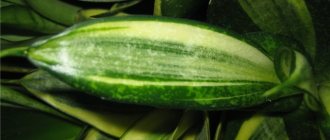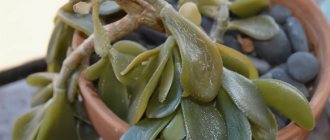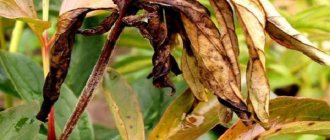Overfeeding with fertilizers - the stem cracked.
The causative agents of cacti diseases are bacteria, fungi and viruses. Some diseases can be cured quite easily, but most cause significant damage to health and lead to the death of plants. Sometimes the symptoms are so imprecise and occur in a latent form that it is not possible to determine the disease.
Therefore, it is much easier to prevent diseases than to cure the sick, especially when there is not just one cactus, but a whole collection. Preventive measures include strict adherence to plant maintenance conditions and hygiene.
This cactus was frozen; cold air was blowing on it from a gap in the frame.
Unfortunately, in most cases, cacti diseases end sadly. The plant either dies or is disfigured. And still, most cactus growers are tormented by two questions: “why?” and “how to treat.”
Even after all the repeated explanations that in most cases the cause of disease is a violation of the conditions of detention, people cannot believe that just by opening a window once (in the evening in cold weather) an unfortunate cactus can become covered with rusty spots and the like. But in reality it is so. Even an experienced cactus grower suffers losses from his fleeting mistakes. Only compliance with all conditions, attention and prevention can prevent the occurrence of diseases.
The fact that a cactus is “sick” is not always immediately obvious. What is most often forgotten is that:
- opened the window in the evening in cool, windy weather;
- poured cold water over the cactus;
- that any wounds, cracks and cuts should be sprinkled with sulfur or crushed coal;
- A cactus must be gradually accustomed to the bright sun, even the most sun-loving one;
- that cacti need a cool and dry winter.
If a cactus gets sick, first of all you need to remember and analyze what violations might have occurred in the conditions of detention, and whether you did everything correctly.
Sometimes disease, pest damage or the result of care errors is not immediately visible. How to understand that something is “unwell” with a cactus, something is bothering it - just be careful. You should worry about the cactus in the following cases:
| External signs | Possible reasons |
| If there is no visible growth of the cactus (only in spring and summer) | Lack of plant growth in spring or summer is the first sign of some trouble. The reason for this can be absolutely any: disease or pests, or an error in care - first of all, lack of light, moving the cactus to a new place, improper replanting, watering with cold water, etc. After vaccination, as it causes a stressful situation. After too long and intense flowering, growth may also slow down or stop due to exhaustion of the cactus. |
| If the stem shrinks or shrinks | If the stem is hard to the touch, then first of all you should exclude a lack of moisture in the soil (i.e. watering, the soil is dry), especially if the cactus is in intense light. If the stem, on the contrary, is soft, then the reason is most likely due to excess moisture (the soil is damp); at this stage the plant can rarely be saved; you can try an urgent replanting with the removal of all rotten roots. |
| If there is a change in color of the stem or leaves | This is a fairly common reaction to changing conditions. When moving a cactus to a new location. When the light changes (if the light is too bright, the stem and leaves may become light or red). When water gets on the stem or leaves (if the plant does not tolerate this). Some cacti are genetically programmed to change color with age. With some diseases, the color of the stem and leaves may also change, most often yellowing, browning and mosaic coloring appears. |
| If leaves or buds are dropped | This may be the first reaction to a stressful situation caused by changes in living conditions. Rearrangement to a new place or even because the cactus was turned the other side towards the light source. If lighting, watering or temperature suddenly changes. For example, they poured cold water on it. If the transplant is carried out at the wrong time or incorrectly. From the discrepancy between micro- and macroelements in the soil. This can also happen due to disease or pest damage. |
| If shoots die off | This happens most often when the roots are damaged during replanting or watering with cold water. From a sharp drop in temperature or exposure to a draft. This can also happen due to disease or pest damage. |
| If various spots or yellowing appear on the skin | This is possible from water getting on the stem or leaves (if the plant does not tolerate this). An untrained cactus can get sunburn from exposure to sunlight. Exposure to cold air may cause rust spots to form on the stem. If there is a lack of nutrients in the soil, yellowing may occur, which disappears after fertilizing with mineral fertilizer. Yellowing or spots also appear due to various diseases and pest infestations. |
| If wounds or cracks appear on the cactus | This howling can be caused by mechanical injuries. When there is an excess of organic matter in the soil, the cactus grows vigorously, and the skin cracks and bursts. |
| If damage or rotting of roots is detected | The cause of root rot should be sought primarily in waterlogging of the soil. Especially with a lack of light and low temperatures. Root rot often begins when damage, cuts or wounds on the roots are not treated with sulfur (which is needed for drying and disinfection). Insufficient soil moisture at high temperatures and light levels can lead not to rotting, but to the death of some of the roots. This happens especially often when the pot overheats in the sun in summer. |
| No flowering or short flowering. | A common reason is a lack of sunlight, lack of a cold winter (rest period), any violation of watering regimes and temperature. Some cacti, on the contrary, do not bloom due to too intense or prolonged lighting. Incorrect or untimely transplantation. Inconsistency in soil pH or composition. Lack of nutrients in the soil or their excess. Rearranging the cactus to a new place or turning it in place. Diseases and pest damage are also the reason for the lack of flowering. |
Treatment of wet and dry rot
Perhaps the most dangerous enemy of a cactus is rot. Rot is caused by microorganisms and can manifest itself in a wide variety of forms. Basically, there are two types of this disease:
- Wet rot
- Dry rot
Of course, it cannot be argued that such a classification comes from biological terms. Nevertheless, it most functionally and very qualitatively reflects the essence of the situation that has arisen.
In most cases, the spots look like white cotton wool or sticky whitish mold .
The most common problem that occurs, especially among novice cactus growers, is root rotting. In the article about proper watering of a cactus , we examined in detail all the nuances and subtleties associated with moistening the soil in a pot.
The topic of proper watering of succulents is a completely different story. It is incorrect watering, with serious mistakes, that leads to such disastrous, terrible results. This is the most common reason that leads to the complete death of a prickly pet.
The main problem with root rot in a plant is that the roots in the ground , in fact, simply begin to decompose. At the same time, the ongoing processes poison the entire soil around the cactus with secretions. It is the dead part of the roots, which decomposes due to the work of microorganisms, and is the main focus and source of all kinds of pathogenic agents of various types of rot.
Of course, all these processes do not happen instantly. They require some time. It is precisely during this time period that you can try to save the succulent.
Of course, the most correct, simple and effective way would be to prevent these situations from occurring. The main thing is to try at any cost to stop the negative processes that have already begun. Next, it is necessary to urgently take all necessary measures to save the plant. Return and place the prickly pet in the correct, comfortable and most suitable conditions of detention.
The main signs that simply must alert the attention of a cactus grower:
- Your favorite cactus has begun to grow much slower than usual
- The cactus stopped gaining turgor after watering. The point is that the succulent does not gain the usual elasticity and density of the main stem after storing moisture during watering.
What to do when rehabilitating the roots of a cactus when rotting
Under natural conditions, cacti have adapted to survive in the heat and easily tolerate drought and sudden temperature changes. But even these plants can experience root rot. This is a consequence of excess moisture, caused by improper care and unsuitable conditions for maintenance. Cacti suffer from pests, viruses, infections and lack of sunlight. Often, infection begins from the bottom, and the owner notices late that the roots of the cactus have rotted and needs to be saved.
How to cure a cactus from rot
If the root system of the cactus feels good, it makes sense to transplant the plant into a new container with fresh soil. Perhaps even slightly increase the size of the new pot .
If there are serious concerns about pests in the soil , then it is necessary to make water baths. That is, the roots of the plant must be completely washed from the old soil.
Only after this procedure, transplant the plant into new soil. This operation must be carried out as carefully as possible, avoiding damage to the small roots.
Unfortunately, in most cases of root rot, cacti have practically no living roots. From the root system, often only one name remains. Instead of healthy, white, strong roots, you can only see small, thin whitish threads with an unhealthy tint. In some places, they also begin to rot and decompose.
When treating a cactus for root rot, all dead roots must be removed.
Prevention against illnesses
There are cases when cacti are affected by incurable diseases. Competent care and normal hygiene will help save them from death. Of course, we're not talking about handwashing during a pandemic. There are a few simple rules.
When buying a cactus, flower growers pay attention to the root system (if possible), needles, and flower body. The culture should not have:
- dents;
- points;
- spots;
- mold elements.
Inspecting for the presence of pests will not hurt either. For example, a miniature white dot indicates the habitat of a mealybug. The brown spot is a disguised microscopic scale insect. This plant should not be brought into your home.
If the choice fell on a completely healthy succulent, the problem may appear later. Therefore, new “pets” are given a month-long quarantine away from other plants. When replanting cacti, be sure to disinfect the soil and wash the pots with hot water.
Rot on a cactus stem
No less rare is wet rot on the main stem of a cactus. It is much more noticeable. Unfortunately, it also happens faster. Externally, it looks like a large wet, black spot. Sometimes it has a brownish tint. May often appear pure brown in color.
Unfortunately, this problem becomes very visible only when a significant part of the surface of the succulent is already affected.
If you find similar signs on your cactus, then all these lesions must be cut out to a clean section of the stem. You need to get to the place where the lesion is completely absent. After cutting and removing, there should be living, healthy plant tissue everywhere.
If the places in need of rot removal were minor, then the plant will cope with it quite easily and the damage will quickly overgrow. However, ugly scars will remain on the cactus for a very long time, in especially advanced cases - forever.
It is worth noting that in the case of serious amputations of significant parts of the plant, the cactus can be deformed to a frankly ugly shape and remain that way for many years.
How to resuscitate when a flower is completely damaged?
It also happens that people go on vacation, entrusting their “green hedgehog” to the care of a neighbor, and upon returning they find their pet in a terrible state, rotten to the very top.
What are the chances of rehabilitation?
If the top has survived, you can try to root it. For this:
- the healthy part is cut off and dried in an upright position for several days;
- the cut site must be treated with coal or sulfur;
- then the surviving part is planted in dry soil with infrequent watering until roots appear.
Dry rot on a cactus
Another disease is no less dangerous - dry rot on a cactus. With this disease, there is no rot as such. That is, rotting and decomposition does not occur and is not even observed. However, externally the plant begins to dry out from the inside and externally changes its shape. In some severe cases, the color of the stem also changes.
What is surprising is that the plant becomes dry inside. That is why this disease received such a fancy name.
Unfortunately, these processes proceed very, very quickly. The worst thing is that this disease simply does not have an initial period. The problem becomes obvious only when time has already passed and it is almost impossible to do anything.
The nature of this disease is practically not studied. Very little is known about him. That is why there are no effective treatment methods or ways to save plants.
The most appropriate solution is prevention. We can only talk about preventing the occurrence and development of this disease. Of course, the key to successful prevention will be compliance with all necessary conditions of maintenance and creation of maximum comfort for the succulent.
However, no one has yet canceled the treatment of diseased plants with fungicidal preparations. It is simply pointless to dispute their high efficiency. They work extremely effectively against most fungal pathogens.
I would also like to note that preventive spraying with fungicides also gives excellent results in preventing the occurrence of diseases caused by various fungi.
Quite often, rot makes itself felt on young crops of seedlings . Cactus crops are a high-risk area. To prevent such situations, it is necessary to dry all crops for at least two or three days. Interestingly, exposure to direct sunlight or exposure to ultraviolet light is also very effective in combating this disease.
Thus, to summarize, the most effective methods for combating dry rot are:
- UV treatment or exposure to direct sunlight
- Drying young crops, preventing excessive waterlogging of the soil
How to care?
Cactus is a plant that does not require special attention. However, certain rules must be followed to avoid infection with rot.
- This plant requires a lot of light; the cactus should be placed on or near a windowsill.
- The cactus should be watered as needed, adhering to the principle “the warmer the room, the more abundant the watering,” but not more than once every 2 days.
- During the dormant period, water the cactus once every 1.5-2 weeks, monitor the temperature and lighting in the room.
Caring for a cactus should be approached carefully and responsibly, although it does not require as much effort as other indoor plants. With the right approach, the cactus will delight its caring owners for many decades.
How does rot occur on a cactus?
How do rot pathogens get into plants? The answer to this question is quite simple. The main reason for the penetration of pathogenic microorganisms is damage to the integument of the plant stem. In some cases, damaged areas on the roots. Many varieties of pathogens can easily live inside the plant and be carried within the stem, causing massive, widespread destruction. Naturally, the most serious consequences will be in vulnerable places, not weakened specimens.
Remember - it is easier to prevent than to try to cure later.
How do diseases manifest themselves and what causes them?
Externally, the pathology does not become noticeable immediately. First of all, small spots, plaque, cobwebs or a change in the color of the stem may appear. Gradually the condition will worsen, the problem will become more pronounced. In advanced cases, the body of the cactus shrinks, decreases in size, or, on the contrary, swells and cracks. Necrotic, foul-smelling masses may appear.
As a rule, it is no longer possible to save such specimens. For this reason, you should regularly inspect the plant and analyze the compliance of its growth and development with the given growing season.
The main causes of cactus diseases:
- physiological;
- fungus;
- bacterial infection;
- viral infection;
- pests
How to treat cacti from spotting
No less rare is the so-called spotting of cacti. It is rather weak and little studied. In general, it does not occur often. Spots and their types are very difficult to recognize, much less distinguish between each other. Especially if you are a beginner cactus grower - an amateur. This task is very difficult even for an experienced succulent plant collector who has been cultivating cacti for 10-20 years!
Spots are caused by pathogens and viruses. A very important fact should be taken into account here. In the vast majority of cases, only weakened plants are affected. That is, again, we return to the basics - prevention. The key factor to prevent the development of these diseases is to keep the plant in the most comfortable conditions for it.
Rust colored stains
Rusty-colored spots on the cactus appear mainly due to hypothermia. The plant was probably exposed to low temperatures for too long. It is also possible that the required temperature does not correspond to the current time of year . In these cases, the stains are even browner and darker in color than rust. The brownish color of the spots clearly indicates that the plant is in extremely low temperatures. It is unacceptable.
Rust on a cactus stem can also signal increased air humidity. Remember, cacti are desert dwellers . There is no humid air there. These plants prefer and need dry ambient air space. In addition, increased humidity in the air stimulates the development and activity of most pathogenic fungal diseases.
Sometimes, rust spots may appear with small growths and mosaic patterns. There are also cases with “depressed” spots on the main main stem. Removing these spots surgically often does not lead to the expected results. Very often the plant cannot be saved.
How to treat cactus spotting
There are a huge number of folk remedies and methods. However, from our point of view, the vast majority of them are ineffective. The saddest thing is that the effect is achieved only partially and temporarily, and after that the disease progresses and the result is disastrous.
A much more effective way to combat this disease is professional “chemistry” - fungicidal preparations. Spraying with fungicides gives the most noticeable and effective results. Also, it is equally important to move the cactus to a more suitable place for the period of treatment. It is vitally important to provide the prickly friend with the most suitable cultivation conditions for it.
If the disease has affected the ampelous type of succulent, then partial removal of the affected shoots must be done.
Powdery mildew
This common fungal disease, which is also called ashtray or linen, often affects indoor plants, including cacti. The causative agents of the disease are microscopic exoparasitic fungi; their powdery whitish mycelium develops on the above-ground parts of flowers.
Symptoms of the disease
Pathogenic fungi feed on the vital juices of the succulent, depriving it of useful substances, as a result of which other signs of the disease appear, in addition to white spots, which over time turn into a solid felt coating:
- The cactus becomes lethargic, leaves and stems lose turgor.
- If the plant is preparing to flower, its buds begin to fall off without ever opening.
- Fungal spores cover increasingly larger areas of the flower, disrupting photosynthesis processes. Cactus leaves, if any, dry out, turning into dry “boats”.
It is important! The symptoms of powdery mildew are similar to those of another disease - downy mildew. The second name of the disease is downy mildew; as it develops, the discolored areas acquire a reddish-brown tint. And it requires different therapy.
The main causes of the disease
Powdery mildew affects succulents that are kept in a room with excessively humid air. The same happens when the temperature regime is violated, the soil is waterlogged or when it is oversaturated with nitrogen. The fungi that cause the disease are present in the natural flora of plants, however, with negative changes, their excessive growth is observed.
Pests
At home, cacti are rarely damaged by insects, especially if they have good immunity. Pests can be divided into those that attack the roots and the aboveground part. The latter are more common and more noticeable on fleshy stems. The vital activity of insects can be determined by a yellowed fleshy stem, a whitish coating, various spots and depressions, and a thin cobweb.
The most common pests of cacti:
- aphid;
- spider mite;
- mealybug;
- scale insect;
- root felt.
Aphid
This small insect lives in colonies and reproduces quickly. Pests of cacti feed on the sap from young shoots and buds, which leads to wilting and death. They can be destroyed by washing them off the stem with soapy water or a solution of potassium permanganate. It is not advisable to use only this method, since it is possible that larvae or adults will remain. Biological methods include a solution of ammonia and tobacco. In severe cases, spraying with special insecticides approved for use at home should be carried out.
Spider mites
They get onto the cactus from other plants; they prefer fleshy varieties - Echinopsis, Chamecereus, Rebutia. They are an insect measuring 0.4 mm, moving slowly but reproducing quickly. A favorable environment for the life of the pest is high temperature and dry air. It gnaws through the skin and sucks out the juice of the plant. A sign of damage is brown spots on the stem, light cobwebs. Damage caused by spider mites cannot be restored.
To combat, regular spraying is carried out from a spray bottle. If possible, it is advisable to wipe the stem with soapy water, alcohol, and garlic tincture. Additionally, it can be treated with karbofos, nearonum, cyclamen, and various compositions according to folk recipes. Spraying with an ether sulfonate solution is considered the most effective.
Mealybug
Another name is hairy aphid. The pest is white, 0.5-0.7 cm long, and settles in the folds of the stem or around the thorns, where water does not reach. Spreads quickly over the surface of the cactus. A sign of damage is a white cotton-like discharge, which serves for egg laying. It is most difficult to detect insects on varieties covered with down or hairs.
It is recommended to remove mealybugs from a slightly affected plant using cotton swabs soaked in an alcohol solution. It is permissible to wash off a large colony with a stream of water, after covering the soil substrate with a bag. Additionally, it is advisable to spray with a chemical approved for home use.
Shields
The insect can be spotted by its small, flat scales. The color of the pest ranges from red to dark brown. Scale insects feed on cactus juice, leading the damaged specimen to exhaustion and death. They move slowly, almost imperceptibly. A large colony causes a sticky discharge to appear on the stem. It is recommended to remove settlements with a cotton swab soaked in an alcohol solution. In the case of long and densely growing thorns, treat with Aktara or Confidor solution.
Root felts
The pest attacks during wintering, when the soil is dry. It feeds on the root system, leaving a white cobweb, slightly paler than the roots. You can prevent the death of a cactus by replanting. The roots should be washed with a solution of dishwashing liquid (1 tsp per 1 liter of water). Transfer the treated plant to a fresh substrate. The use of chemicals is acceptable.
Physiological diseases
With proper care at home, the cactus develops well and retains its decorative effect for a long time. Compliance with agrotechnical recommendations is the best way to protect a succulent from infection. Culture requires the creation and maintenance of an optimal microclimate. Variety must be taken into account, since forest species require a more humid environment than desert species.
If the cactus stem turns yellow, becomes soft or dense, but decreases in size, this does not necessarily indicate an infectious disease.
Possible physiological problems:
- suberization;
- abscission of brood buds;
- sunburn;
- chlorosis;
- no growth.
Sampling
With age, the lower part of the stem becomes covered with a tough skin. The process is physiological and is necessary for the plant to impart stability to the overgrown aerial part. At home, with proper care, this part of the cactus is almost invisible, which allows you to preserve the decorative appearance of the plant. It is important for the crop to provide a period of rest to avoid suberization and deformation of the stem.
If there is a lack of light, it is necessary to lower the temperature and almost stop watering. As a result, the succulent acquires a spherical or flattened shape; this area is not visible. The contact of the stem with the soil, the ingress of water on it, the activity of spider mites are common reasons why a cactus turns yellow and the skin becomes dense. You can mask the defect by mulching the surface of the soil substrate with pebbles.
Kidney abscission
A similar problem occurs when there is a lack of moisture in the air, insufficient watering, deficiency of fertilizers, or low room temperature. Often the buds fall off after moving a flower pot to a new place, transplantation done incorrectly or at the wrong time, deficiency or excess nutrition. During flowering, the plant should stand in one place, facing the sun's rays. The cactus gets rid of excess parts when exposed to unfavorable factors.
Burns
In winter, there is less daylight and there is often not enough lighting, so the plant becomes weaned from the sun. In early spring or summer heat, direct exposure to rays leads to the formation of yellowness on the stem. It is no longer possible to get rid of such stains in the future. It is recommended to stop the process as soon as marbling of the surface or slight redness becomes noticeable.
The danger of burns lies not only in the loss of decorativeness - this deprives the succulent of part of the epidermis necessary for breathing. Severe damage can provoke rotting and subsequent death of an indoor flower. For this reason, if you notice damage to a cactus, you should move it to a place protected from the sun and spray it with a spray bottle. Increased humidity over a few weeks can eliminate the symptoms of a mild injury.
Chlorosis
Violation of photosynthesis and slowdown in the formation of chlorophyll leads to yellowing and discoloration of the stem. White spots may appear. The causes of the disease are various - poor drainage, damage to the root system, unsuitable soil, infections, pests. The main problem is the lack of minerals. Compliance with the regime and rules for applying fertilizing will help to avoid chlorosis.
No growth
The cactus falls into a state of stagnation under unfavorable growing conditions. The physiological norm is considered to be a dormant period, when growth cessation is necessary for the plant to maintain its decorative appearance in the absence of proper lighting. Another possible reason is increased air temperature. Not all representatives of the culture grow in the desert in full sun; some prefer shade and coolness.
Difficulties with growth and recommendations for owners
Sometimes a cactus has certain growth problems. This happens for certain reasons.
Doesn't grow
The growth of a cactus is largely influenced by various minerals and trace elements. They are found in plant food.
- if there is a lack of nitrogen, the cactus stem will grow slowly;
- lack of phosphorus slows growth, the plant turns pale;
- If there is a lack of calcium, the cactus root does not grow well.
The development of a cactus is stopped or slowed down by a lack of boron, copper, iodine and chlorine. All these microelements are present in sufficient quantities in fertilizers for cacti. They must be added according to the instructions.
Stretched out
With a lack of lighting, the plant stem becomes deformed. It begins to reach towards the light source, so it turns out elongated. You can correct the situation by placing the pot with the cactus on a light windowsill and rooting the cut top.
This is what a cactus looks like when it stretches out:
Bent down
A cactus can bend over due to rotting of the root system, which does not hold the plant properly. You should remove the flower from the pot and inspect the root. If there are rotten areas, they are removed.
This is a cactus that has bent over:
Read about why the cactus is stretched out or bent and how it can be straightened here.
Falls on its side
Due to abundant watering, a cactus can stretch upward and soften, as a result it falls on its side. In this case, replanting and reducing watering will help.
The cause may also be helminthosporiosis. In this case, the dried areas are cut off, and the plant is transplanted into new, pre-disinfected soil.
This is a cactus falling on its side:
Broke in the middle - what to do with the top?
This is what a plant looks like when it breaks in the middle:
If the flower is broken, you can try to root the top.
Watch a video on how to root a piece of cactus:
Postoperative care
“Babies” take root best , but they require more careful monitoring - organizing a greenhouse with maintaining the temperature to 22-25 degrees, lighting.
The most difficult time for cacti to take root is in winter. At this time, they are defenseless against fungal diseases, since all processes inside the plant are asleep.
Plus, the microclimate around is not conducive - a cool window sill, short daylight hours.
We need to try to create “spring” conditions - install additional lighting, organize the temperature at 20-22 degrees.
- Once a week it is worth inspecting the rooted cuttings, as the disease may return.
To understand whether it has taken root, you should shake the cactus slightly and check whether it clings to the ground or not.
All these measures guarantee good rooting by 70-80%. One hundred percent results can only be achieved by grafting onto another cactus - preferably Echinopsis.
General rules of care
A disease is easier to prevent than to cure (what diseases and pests can destroy a plant?). By following these simple rules, you will protect cacti from many misfortunes.
- Do not water cacti with cold water; it is better to let it be at room temperature.
- Reduce watering if the ambient temperature does not exceed 17 degrees.
- Plant cacti in a special sterile substrate.
Do not overfeed cacti with fertilizers. It is better to use specialized drugs.- Quarantine purchased plants before placing them in a permanent place next to other flowers.
- Harden the cacti - take them out into the fresh air in the summer, and put them in a cool room in the winter.
- Carry out preventative maintenance twice a season.
Despite their harsh appearance due to their thorns, cacti are delicate plants that require careful care and constant attention . Following simple rules will allow you to preserve and increase their population both on the windowsill and in multi-level compositions of public greenhouses.
If you find an error, please select a piece of text and press Ctrl+Enter.











